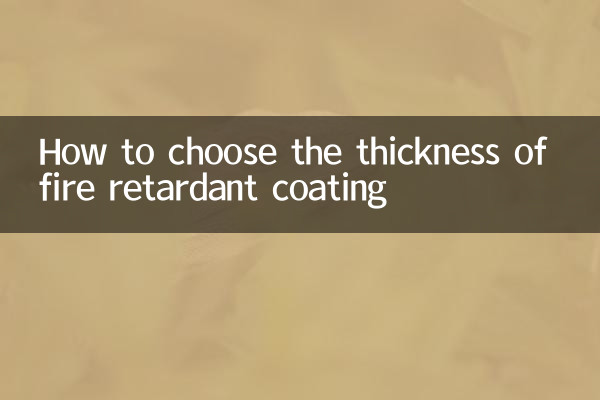How to choose the thickness of fire retardant coating
In modern buildings and industrial facilities, the application of fire-retardant coatings is becoming more and more widespread, and the choice of its thickness is directly related to the fire-retardant effect and safety. This article will provide you with a detailed analysis of how to scientifically select the thickness of fire-retardant coatings from three aspects: the classification of fire-retardant coatings, basis for thickness selection, and precautions in practical applications.
1. Classification and applicable scenarios of fire retardant coatings

Fire retardant coatings are mainly divided into the following categories based on their ingredients and uses:
| Type | Main ingredients | Applicable scenarios |
|---|---|---|
| Intumescent fire retardant coating | Resin, flame retardant, foaming agent | Steel structure, wooden structure |
| Non-intumescent fire retardant coating | Inorganic adhesives, refractory fillers | concrete structures, tunnels |
| Water-based fire retardant coating | Water-based resin, flame retardant | Interior decoration, public places |
2. Basis for selection of fire retardant coating thickness
The thickness selection of fire retardant coatings needs to comprehensively consider the following factors:
| factors | Description | reference standard |
|---|---|---|
| Fire protection grade requirements | Determined based on the fire protection rating requirements of the building or facility | GB 14907-2018 "Fire retardant coatings for steel structures" |
| Substrate type | Different base materials such as steel structures and concrete have different thickness requirements. | JG/T 125-2016 "Fire retardant coating for steel structures in buildings" |
| environmental conditions | Environments such as humidity and temperature affect the performance and thickness of coatings | ISO 834-1:1999 "Fire resistance test" |
| Coating properties | Performance indicators such as thermal conductivity and expansion ratio of coatings | Technical parameters provided by the manufacturer |
3. Precautions in Practical Application
1.Preparation before construction: The surface of the substrate must be clean, dry, and free of oil and rust to ensure the adhesion of the paint.
2.Thickness measurement: During the construction process, a thickness gauge needs to be used to monitor the coating thickness in real time to ensure that the design requirements are met.
3.Layered construction: For thicker paint, it is recommended to apply it in layers, and apply the next layer after each layer is dry.
4.environmental adaptability: When constructing in a high-temperature or high-humidity environment, the paint ratio and construction process need to be adjusted.
5.Acceptance criteria: After the construction is completed, acceptance must be carried out in accordance with relevant standards to ensure that the thickness and performance of the fire retardant coating meet the requirements.
4. Frequently Asked Questions
Q: Is the thicker the fire retardant coating, the better?
A: No. Paint that is too thick may cause cracking and peeling, which may in turn affect the fireproofing effect. The appropriate thickness should be selected according to actual needs.
Q: How to judge whether the thickness of fire retardant coating meets the standard?
A: It can be tested with a thickness gauge, or a third-party agency can be entrusted to conduct testing in accordance with relevant standards.
Q: What is the relationship between the thickness of fire-retardant coating and fire-retardant time?
A: Generally speaking, the greater the thickness of the coating, the longer the fire protection time, but the specific relationship needs to refer to the technical parameters of the coating.
Conclusion
The selection of fire retardant coating thickness is a highly professional task that requires comprehensive consideration of many factors such as material performance, construction conditions, and fire protection requirements. I hope this article can provide you with valuable reference to help you scientifically choose the thickness of fire retardant coatings to ensure the safety of buildings and facilities.

check the details

check the details